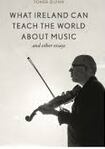
The Journal of Music has shone a light on Ireland’s jazz, contemporary, classical and traditional scenes since 2000, publishing 60 print editions before migrating to its current guise as an online magazine. Such longevity is rare in the precarious world of music media, which suffered another high-profile casualty with the recent news that Condé Nast were subsuming the Pitchfork brand into GQ.
Toner Quinn taps into a crucial unsung component behind Irish music’s continuing success on the world stage. The emergence of artists garnering an international audience such as Lankum, Fontaines DC, Lisa O’Neill, Sprints, John Francis Flynn, New Dad, ØXN, plus scores of others, never would have happened without a spell incubating in this country’s fertile underground.
We are quick to champion the blossoming of numerous contemporary traditional acts of late, but not always so supportive of the scene’s grassroots and infrastructure. Lest we forget, if some had their way, the Cobblestone pub and Irish music school in Smithfield would be yet another hotel. This debacle is referenced in a piece from November 2022, 10 Impossible Ideas for Irish Traditional Music.
Despite its rather portentous and presumptuous title, What Ireland Can Teach the World About Music is an engrossing appraisal of the magical power of musicians to soundtrack our lives and times and a powerful compendium of necessary ideas. The final essay, from August 2023, How Ireland Treats Its Free Thinkers: The Life and Death of Sinéad O’Connor, is among the finest tributes penned to her to date.
Indulging Kleptocracy: How democracies hollow themselves out as thieves take advantage
The Language of Remembering by Patrick Holloway: An utterly readable book of real depth
What Eddie de Valera read: an English idyll and Robinson Crusoe
A Brave New Ireland: How dystopias can reflect the state of Ireland and the West
“The silence that surrounds dissenters is, we know well, an Irish fear: a long-held, deeply felt apprehension of being associated with the troublemaker, the danger-maker, the dissenter,” Quinn writes. “It is a lesson learned from our colonised, violent history: if they speak up, we all go down. Say nothing and let it pass. O’Connor knew this traditional Irish practice but would not, or could not, stay silent.”
In this collection of lively, informative and insightful essays, which are compiled chronologically and divided into four parts, Quinn steers an invaluable discussion of non-mainstream music and the creative realm. To borrow a lovely phrase from Ian Winwood’s important 2022 work about mental health and the music industry, Bodies: Life and Death in Music, as the 21st century approaches its first chorus, Quinn and The Journal of Music have made a precious contribution to documenting Irish music for future generations.














